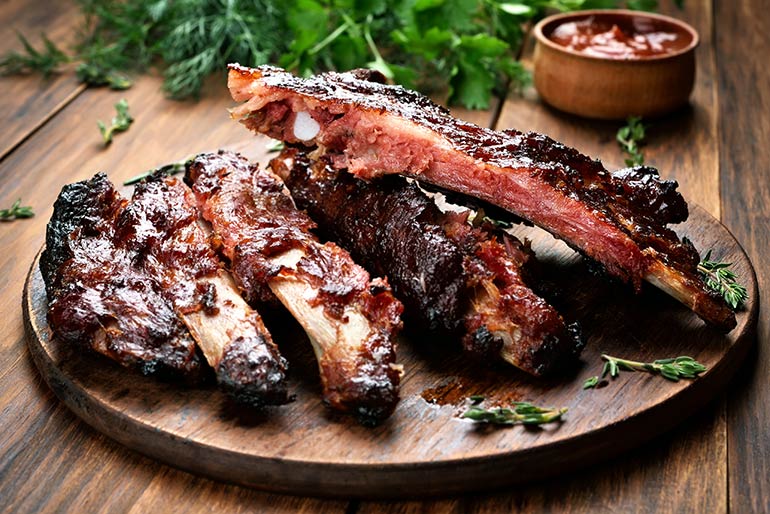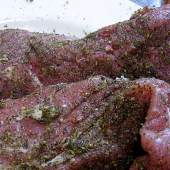Barbecue

As anyone with a backyard grill can tell you, there are a wide variety of foods that can be cooked on it. Invite the neighbors, heat up your charcoal briquettes, toss your burgers, brats, vegetables, and what-have-you on the grill, serve it all up with a bottle of grocery-store sauce and deli side dishes, and voilà! You have yourself a barbecue. Easy-peasy.
But if you’re a true barbecue traditionalist, you don’t…not really. A cookout, maybe – but not a barbecue, which is all about slooooow cooking, wood-smoking, and a wide variety of regional sauces and spice rubs. And pork. Other meats, of course…but mostly pork.
Barbecue, as a genre, is about as close to Americana as you can get. But like so many of our culinary traditions, it really originated somewhere else: in the Caribbean. Legend has it that when Christopher Columbus arrived in the land he later dubbed Hispaniola after sailing (as the nursery rhyme goes) “the ocean blue,” he saw natives slow-cooking meat in a pit over indirect heat, filtered through a “grill” of green wood, which kept it and the meat from catching on fire. The Spanish conquistadors who followed in his footsteps brought this method, which they christened barbacoa (a term you will often see on Mexican restaurant menus), north to the Americas. According to Smithsonian magazine, “in 1540, close to present-day Tupelo, Mississippi, the Chicksaw tribe, in the presence of explorer Hernando de Soto, cooked a feast of pork over the barbacoa.” It must have gone over well, because settlers subsequently spread it north and west, where it picked up European and other influences along the way.
Why is pork the meat of choice? Smithsonian goes on to explain: “The original BBQ-ers of the southern colonies depended on the cheap, low-maintenance nature of pig farming. Unlike cows, which required large amounts of feed and enclosed spaces, pigs could be set loose in forests to eat when food supplies were running low.” Pork was therefore both economical and uniquely suited to this technique of tenderizing cooking. Of course, ribs, chicken, beef, and other meats are very popular, but pulled pork remains at the top of the barbecue heap.
Pulled barbecue pork sandwich
Moving on to the wood for smoking – the kind of wood to be used varies according to the kind of meat you are cooking, and whether you want a stronger or milder flavor. Stronger is usually better for beef and pork, so you would use a hard wood such as mesquite, hickory, oak, or pecan. For poultry and fish, a milder flavor is more suitable – this is achieved by using a softer wood from a fruit tree (pear, apple, cherry, etc.) or perhaps a maple. Another popular smoke flavor comes from sassafras, which is a main ingredient in root beer.
There are many regional styles in barbecue sauce (including St. Louis, California, Alabama, Virginia, Hawaii, Oklahoma, and Kentucky, for example), but over the years this list has been pretty much winnowed down to four main categories that are in hot competition with each other:
Carolina style – this is strictly pulled pork, and the emphasis is more on the smoking than on the sauce. That said, within this genre, there are three distinct regional categories:
- Eastern North Carolina – the pig is roasted whole, and the sauce is composed of vinegar and black pepper (sometimes a red or cayenne pepper is also added to give the sauce an extra kick). This can be an acquired taste for folks who are used a tomato-based sauce;
- Western North Carolina – roasters here prefer the pork shoulder, and while the sauce does incorporate the mandatory vinegar, ketchup and brown sugar are added, which gives it a tart but “tomato-y” taste;
- South Carolina – The pork shoulder is also favored here over the whole hog approach; the main difference here in the sauce is the addition of mustard, thought to be an innovation from German immigrants.
Texas style – Texans tend to go for beef, and this style has four regional variations:
- West Texas – this is also known as “cowboy style” and it involves mesquite wood and direct heat.
- Central Texas – the wood used here tends to be oak or pecan, and involves a spice rub.
- East Texas – the meat is slow-cooked over hickory wood and slathered with a tomato sauce.
- South Texas – this method is influenced by its Mexican neighbors, and involves a sauce like molasses, thick and very sweet. This is the closest to the age-old barbacoa technique used by the Spanish.
Memphis style – Ribs are king here, in wet and dry incarnations (wet with sauce, dry with a spice rub). Aficionados of this technique are also fond of chopped pork, which they reportedly love to put on many non-barbecue related foods such as pizza and spaghetti, and also as a sandwich filling.
Kansas City style – If you like a variety of meats (and French fries!), Kansas City barbecue is for you. There is smoked beef, pork, and lamb with a dry rub, and its sauces (equally diverse) are generally served separately so you can add them to your taste. Barbecue was brought north to Kansas City by Southerners (especially freed slaves) after the Civil War, and it is an important part of the local culture.
Of course, other countries have their own version of this genre, including Argentina, Korea, Taiwan, and many others. But by far, Americans consume more home-style barbecue than anyone else in the world.
Popular sides with barbecue include cornbread, cole slaw, baked beans, mac ‘n’ cheese, and hush puppies (deep-fried cornmeal bits of heaven!). And in the grand Southern tradition, customary desserts include fruit cobbler and bread or banana pudding.
Where can you enjoy authentic barbecue in Chicago? Check, Please! reviewers have been glad to tell us! As the summer draws to a close, check these out, and enjoy!





